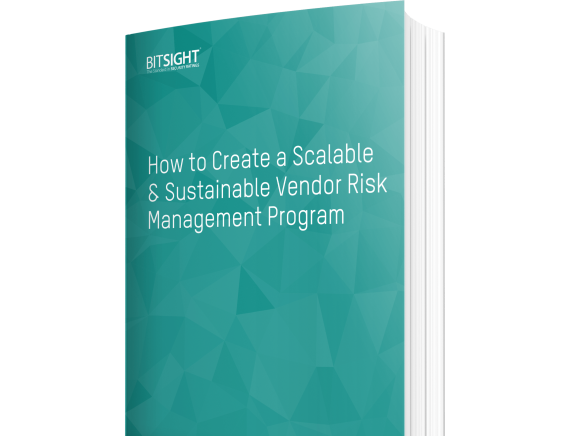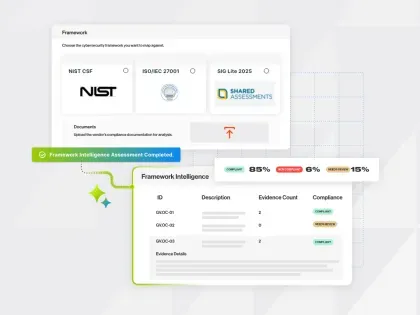Learn how to create a scalable & sustainable vendor risk management program to see what it takes to create a VRM program that’s ready and able to stand up to our interconnected economy
4 Best Practices for Supply Chain Cyber Risk Management

Cyber risk management should be a priority for any organization. And while there are many measures your business can take to reduce cybersecurity risk across the enterprise, how do you discover and remediate unknown risks that may be lurking in the networks of third parties?
Supply chain breaches are surprisingly commonplace. A study by Opinion Matters found that 92% of U.S. organizations have experienced a breach that originated with a vendor.
But when you’re dealing with dozens if not hundreds of third parties – some who handle sensitive data – third-party cyber risk management can quickly become overwhelming.
Let’s look at four ways you can effectively expose and rectify cyber risk in your organization’s supply chain.
What is cyber risk management?
Cyber risk management is the task of identifying possible cybersecurity risks internally and across your supply chain, then proactively deciding how to approach and mitigate those risks. A proper cyber risk management program allows you to implement the correct security measures based on a number of unique factors, including your organization’s risk tolerance, the probability of an attack and, most importantly, the potential damage that could be incurred from each attack scenario.
With the right strategy and tools you can significantly reduce cybersecurity risk in your supply chain. Here are four approaches that work.
1. Understand the scope of your supply chain ecosystem
The first step in any cyber risk management strategy is identifying each service provider within your supply chain.
Your company’s legal or procurement team likely maintains a list of all your third-party vendors. What about potentially risky fourth parties within your extended supply chain? As your service portfolio expands to include more cloud technology and shadow IT, it’s hard to grasp the complex web of interconnected business relationships that exists. You need a way to quickly and easily uncover connections and enhance visibility into your supply chain, including your vendors’ use of subcontractors and service providers.
2. Assess the risk posture of your third and fourth parties
Most organizations adopt a traditional approach to assessing supply chain risk. This involves risk assessment questionnaires, annual security audits, penetration tests, and on-site assessments. These are all essential tools, but they fail to offer a complete view of cybersecurity risk. That’s because they capture a point-in-time glimpse into your vendors’ security postures. Typically, they also fail to uncover cyber risks that a supplier may not be aware of – or are even honest about. For instance, are they open about the steps they take to manage cyber risk in their own supply chain?
A better option is to use a continuous monitoring solution like Bitsight for Third-Party Risk Management. Based on the Bitsight Security Ratings platform, the solution provides an immediate, near real-time snapshot of your third parties’ cybersecurity postures. A higher rating denotes better security, while a lower rating means improvement is needed.
Using these data-driven insights, you can speed up the vendor onboarding process and, once the contract is signed, keep tabs on your vendors’ security postures for the remainder of your partnerships. Bitsight also allows you to add fourth parties to your list of continuously monitored vendors for a complete view of your organization’s risk surface.
3. Communicate findings with your vendors
Using the Enable Vendor Access (EVA) feature in Bitsight, your organization can triage risk in collaboration with your vendors.
When you grant a vendor access to the Bitsight platform, they can investigate forensic data on potential security issues in their environment, such as vulnerabilities, malware, or user behavioral anomalies.
This capability is particularly valuable in the case of large-scale cyber attacks. Instead of sending multiple emails, you can quickly reach out to your vendors as a group and provide them with access to the EVA feature. In seconds they can proactively assess their ecosystem for cyber risks, such as exposure to ransomware, and take appropriate action.
The EVA feature also lets you trust but verify. For example, you can check which vendors have accepted your invitation, view recent actions they have taken, and see how those measures have improved their security posture in specific areas, and overall. When your vendors take proactive steps to manage their cyber risks, it translates to reduced risk for your organization.
4. Share cyber risk management assessments and outcomes with executives
Finally, Bitsight’s suite of tools make it easy to communicate supply chain risk as well as the tangible outcomes of your risk management program in non-technical terms. This is especially important when communicating risk levels to executives who may not be fluent in technical cybersecurity jargon. This is a positive for any organization. With clear and open dialog about third- and fourth-party risk, executives and board members can transform how risk is assessed, managed, and scaled across the vendor ecosystem. Likewise, vendors will be empowered to proactively improve their cybersecurity programs.
For more information about how to optimize your supply chain cyber risk management processes, download our free ebook, Revolutionize Your Vendor Risk Management Strategy.



